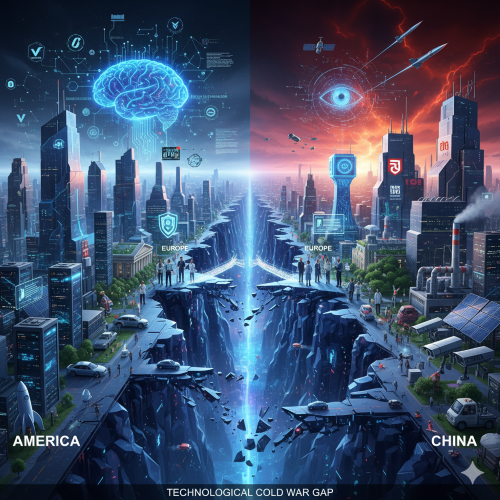How are Chinese elites leveraging technology to expand influence in Africa, Asia, and Latin America, compared to U.S. and European strategies?

Chinese elites are leveraging technology to expand influence by building a state-driven digital infrastructure that offers a complete, low-cost package of hardware, software, and services.
This strategy, known as the Digital Silk Road (DSR), contrasts sharply with the U.S. model, which relies on private-sector market dominance, and the European approach, which focuses on regulatory standards and development aid.
China's Strategy: The Digital Silk Road
China's approach is a top-down, "whole-of-nation" effort. Beijing views technology as a strategic tool for national power and uses the DSR to export its technological ecosystem and governance model. This strategy is attractive to developing nations because it's a complete package that addresses urgent needs with a low-cost, high-speed solution.
-
Building Physical and Digital Infrastructure: The core of China's strategy is building the physical and digital infrastructure that underpins a modern economy. This includes:
-
5G Networks: Huawei has become a global leader in 5G technology, providing affordable and efficient networking equipment. While the U.S. has lobbied allies to ban Huawei over security concerns, many African and Latin American countries find its price and quality too good to pass up.
-
Submarine Cables and Satellites: China is investing in undersea fiber optic cables to connect continents and launching communication satellites, building a global internet backbone that is centered on its own network.
-
Smart Cities: Chinese companies are exporting "safe city" technology, which includes extensive surveillance systems with facial recognition, integrated into command centers. This technology is often sold as a tool for public security, but it also provides a governance model that is attractive to authoritarian regimes.
-
-
Exporting a Complete Ecosystem: China isn't just selling hardware; it's selling an entire ecosystem. This includes:
-
Smartphones: Chinese phone manufacturers like Tecno, Infinix, and itel dominate the African and Latin American markets with affordable, feature-rich devices tailored to local needs.
-
E-commerce and Fintech: Chinese companies are establishing e-commerce platforms and digital payment systems that provide a seamless user experience, and they are incentivizing developing nations to join China's digital trade networks.
-
Data Centers: China is building and operating data centers in developing countries, raising concerns that it could gain access to sensitive government and citizen data.
-
-
Geopolitical Influence: This technological expansion is a powerful tool for geopolitics. By providing infrastructure, China creates a long-term technological and economic dependence. It also sets standards for digital governance, which are often more permissive regarding data collection and state surveillance, in stark contrast to Western models.
The U.S. and European Strategies: Lags and Disadvantages
The U.S. and Europe, in their efforts to compete, are held back by their different priorities and a more fragmented approach.
-
The U.S. Model: Private-Sector-Led and Reactive: The U.S. relies on the private sector to expand its influence. Companies like Google, Meta, and Amazon have a massive global footprint, but their expansion is driven by market opportunities, not a direct government mandate. This model has several disadvantages:
-
Lack of a Unified Strategy: The U.S. government has not historically provided a unified, state-backed alternative to the Digital Silk Road. Its approach has been largely reactive, warning countries about the security risks of Chinese technology without providing a compelling, affordable alternative.
-
Cost Disadvantage: American technology is often more expensive than its Chinese counterparts, making it less attractive to developing nations with limited budgets.
-
Regulatory Friction: American tech giants often face regulatory challenges in developing countries due to concerns about data privacy, monopolistic practices, and the dominance of Western platforms.
-
-
The European Model: Regulatory and Aid-Based: Europe's strategy is driven by its commitment to development aid and a values-based approach. The EU's Global Gateway initiative is designed to provide an alternative to the DSR by focusing on sustainable and value-driven projects, including digital connectivity.
-
Focus on Standards: Europe's primary export is its regulatory framework, most notably the GDPR. It aims to share its experience in building open and secure digital ecosystems. However, this regulatory focus is often seen as a constraint by developing countries that prioritize speed and affordability over strict data protection rules.
-
Lack of Tech Giants: Unlike the U.S. and China, Europe lacks global tech giants with the scale and capital to compete directly with companies like Huawei and Alibaba. Its efforts are often fragmented across multiple member states and depend on public-private partnerships that are slower and less agile than a state-driven approach.
-
In essence, China's elites are winning the technological influence race in developing nations because they have a single, coherent, and highly pragmatic strategy. They are not selling an ideology; they are selling a complete, low-cost technological solution that helps countries industrialize and modernize. The U.S. and Europe, by contrast, are trying to compete with fragmented, values-based, and market-driven models that struggle to offer a compelling alternative.
- Questions and Answers
- Opinion
- Motivational and Inspiring Story
- Technology
- Live and Let live
- Focus
- Geopolitics
- Military-Arms/Equipment
- Seguridad
- Economy
- Beasts of Nations
- Machine Tools-The “Mother Industry”
- Art
- Causes
- Crafts
- Dance
- Drinks
- Film/Movie
- Fitness
- Food
- Juegos
- Gardening
- Health
- Home
- Literature
- Music
- Networking
- Other
- Party
- Religion
- Shopping
- Sports
- Theater
- Health and Wellness
- News
- Culture

